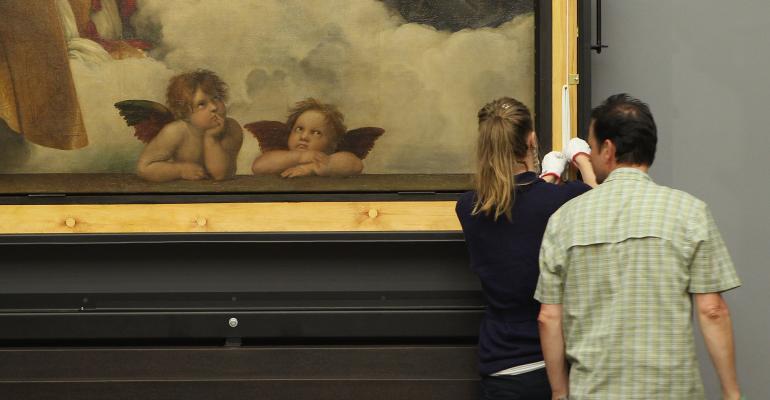By Harvey Bezozi
A person would need the stoniest of hearts to gaze upon Michelangelo’s Sistine Chapel or Picasso’s Guérnica and think about money. We all understand that the true value of a masterpiece cannot be expressed in either words or numbers—no one can put a price on art, the saying goes.
Yet when tax time rolls around, the law requires doing exactly that. The Internal Revenue Service has developed extensive guidelines for converting brush strokes and chisel marks into dollars and cents.
The Guiding Principle: Fair Market Value
Because there is no formula to assign value to artwork, the IRS relies on the principle of fair market value. The inherent flaw in the concept of fair market value is that it is based on a hypothetical situation: If the owner of the art were reasonably knowledgeable about its worth and offering it for sale willingly, and if an equally knowledgeable, willing purchaser emerged, what price would be agreeable to both?
As anyone who has ever watched The Antiques Road Show knows, however, the answer to that question can often only be narrowed down to a range, such as $4,000 to $6,000. It is of course advantageous for a taxpayer to report a value at the upper extreme of the range when claiming a deduction, and at the lower extreme when reporting value for assessment of estate and/or gift taxes.
Mind you, the existence of these incentives is not news to the IRS. Auditors always heavily scrutinize reported values that deviate from the norm in a way that significantly benefits the taxpayer.
Works of Art Are Not Pancakes: “Flipping” Them Does Not Fly with the IRS
Those auditors cast a particularly disapproving eye on any transaction involving artwork that seems to have been completed for the sole purpose of obtaining a tax benefit. Imagine that a couple comes upon a vase priced at $40 at an art sale. From their experience with similar pieces, they know its market value to be in excess of $4,000. They purchase the vase, even though they hate it. They are afraid to offer it for sale, however, suspecting it has been stolen. Instead, they swiftly donate it to a local nonprofit, hoping to claim a $4,000+ tax deduction.
No such luck. If the donation is made during the same year as the purchase, the couple cannot deduct any part of the value of the vase that amounts to a capital gain. The value they can report is therefore limited to $40.
In short, it’s always wise to remember that the IRS hires very smart and well-trained personnel.
Legitimate Determination of Fair Market Value
If the value of a single work of art or a group of works classified as a “set” is clearly $5,000 or less, the IRS grants the owner considerable latitude to assign the item(s) a plausible fair market value. For any object or collection with a value in excess of $5,000, a qualified appraisal performed by a qualified appraiser is required. Detailed explanations of those terms can be found in IRS Publication 561, but the gist of it is that the appraisal must be extremely detailed and the person performing it must really know what they are doing. Your cousin Freddy who often hangs out at art galleries need not apply.
Naturally, an appraisal completed by an expert who specializes in the medium and style of the particular piece of art will carry the most weight. If the appraised value is at least $20,000, a copy of the appraisal must be submitted with all relevant tax forms. If the value reaches $50,000, then things really get interesting.
The Art Advisory Panel and AAS
The IRS may refer any claim of a value of $50,000 or more for a work of art to its Art Advisory Panel, a group of experts serving without compensation to assist the IRS in assessing fair market value. This expert panel is where the buck stops—or rather, the many, many bucks stop—when it comes to tax-related assessment of the value of art. Doing battle with the panel would be a very poor choice for a hobby.
One way to avoid such a battle is to contact the IRS in advance to obtain a statement of value for the artwork. As explained on the IRS website, to exercise this option, a taxpayer must contact the IRS’s Art Appraisal Services, or AAS, to request the necessary forms and instructions before filing any tax return on which the donation, inheritance, or gifting of the artwork is to be reported. Filing the request requires payment of a hefty fee ($5,700 for up to three items, plus $290 for each additional item) and submission of significant documentation, however, in cases where proper valuation may be open to debate, the time and cost may be justified. On receiving a taxpayer’s request, AAS will either provide the statement or decline to provide it for efficiency’s sake and refund the fee.
Art has no rules, but the valuing of art for estate tax, gift tax, and charitable contribution deduction purposes has plenty of them. Taking a cavalier approach to the process amounts to boarding the express train to Auditville. By working with qualified appraisers and an experienced tax advisor, you can ensure that your art always soothes your headaches, instead of causing them.
Harvey Bezozi is a CPA and CFP. More information can be found at YourFinancialWizard.com.





